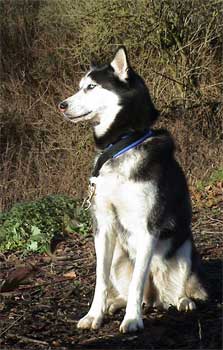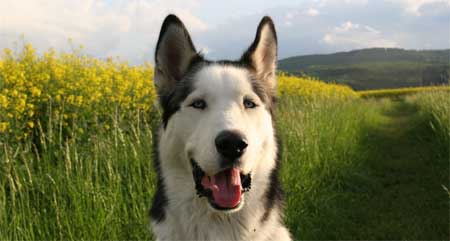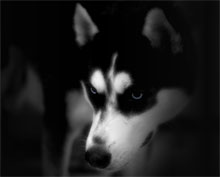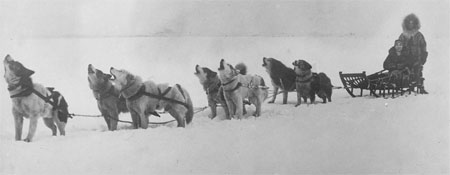|

 A Coat of Many Colors: Siberians have a thicker coat than other types of huskies, that comes in a variety of colors and patterns, usually with white feet and legs, facial markings, and tail tip. The most common colors are black and white, grey and white, copper-red and white, and pure white, though many individuals have brown, reddish, or biscuit shadings and some are piebald spotted. Striking masks, spectacles, and other facial markings occur in wide variety. They have a wolf-like appearance, albeit smaller and with less shaggy fur. A Coat of Many Colors: Siberians have a thicker coat than other types of huskies, that comes in a variety of colors and patterns, usually with white feet and legs, facial markings, and tail tip. The most common colors are black and white, grey and white, copper-red and white, and pure white, though many individuals have brown, reddish, or biscuit shadings and some are piebald spotted. Striking masks, spectacles, and other facial markings occur in wide variety. They have a wolf-like appearance, albeit smaller and with less shaggy fur.
Wild Blue Yonder: : The dogs' eyes are brown, hazel, or blue. Light blue eye colour is characteristic but not completely dominant. The breed may have one eye brown or hazel and the other blue, called "bi-eyed" or may have blue and another colour mixed in the iris of one or both eyes; this latter trait, heterochromia, is called "parti-eyed" by Siberian enthusiasts. This is one of the few breeds for which different-colored eyes are allowed in the show ring. The Siberian Husky is one of the few dog breeds where blue eyes are common.
Foxy: Its ears are triangular, well-furred, medium-sized, and erect; its fox-like brush tail is carried in a sickle curve over the back.
Let me take your coat: The Siberian Husky's coat consists of two layers, a dense, cashmere-like undercoat and a longer coarser topcoat consisting of short, straight guard hairs. Siberians only shed their undercoat once a year; the process is commonly referred to as blowing their coat. Dogs that live primarily indoors often will not shed year round, so the shedding is less profuse. Otherwise, grooming is minimal; bathing is normally unnecessary as the coat sheds dirt. Also, it is not uncommon for a dog of this breed to groom itself carefully in much the same way one might expect of cats. Healthy Siberians have little odor. Their ears are amazingly soft and they have very good hearing.

Call of the Wild: Popular as family pets and as show dogs due to their striking appearance and gentle temperament, Siberians have certain drawbacks. Although they have a wolf-like apperance, Huskies can be extremely affectionate, curious, and welcoming to people, which means they rarely hurt humans, making them poor guard dogs. Properly socialized Siberians are often quite gentle with children, although no dog, including Siberians, should be left unsupervised with small children. Siberian Huskies can be challenging to train due to their stubborn nature and will generally only perform tasks once they see the point behind it. Proper training requires a lot of persistence and patience on behalf of the trainer. Siberan huskies are not generally recomended for first time dog owners, as their strong will and desire to run are difficult to manage without the right knowledge. Siberian Huskies have strong running instincts and therefore as a general rule of thumb should NEVER be left to run free off-lead for their own safety.

Health can be a concern: Siberians are normally rather healthy dogs, living typically from eleven to fifteen years of age. Health issues in the breed are eye troubles (cataracts, glaucoma, and corneal dystrophy among others), allergies, and cancer in older animals. Hip dysplasia occurs but is not a major concern in the breed. This breed needs a high-quality diet with high levels of protein and fat, particularly when used for dogsledding. That said, Siberian Huskies are fuel-efficient dogs, consuming less food than other dogs of similar size and activity level. The diet must be adjusted to their level of work and exercise; obesity can be a problem for underexercised, overfed pets.
 Ready, Set, Go!:Siberians are still used occasionally as sleddogs in dogsled racing but have been widely replaced by the more popular Alaskan Husky and hound-type crossbreds that are specially bred and selected for speed and have less heavy coats. Siberian Huskies were designed to pull a light load over long distances at a medium pace, and simply can't keep up with their faster counterparts. Siberians are still popular in races restricted to purebreds and are faster than other pure sleddog breeds such as the Samoyed and Alaskan Malamute. Today the breed tends to divide along lines of “racing” Siberians versus “show” Siberians. Ready, Set, Go!:Siberians are still used occasionally as sleddogs in dogsled racing but have been widely replaced by the more popular Alaskan Husky and hound-type crossbreds that are specially bred and selected for speed and have less heavy coats. Siberian Huskies were designed to pull a light load over long distances at a medium pace, and simply can't keep up with their faster counterparts. Siberians are still popular in races restricted to purebreds and are faster than other pure sleddog breeds such as the Samoyed and Alaskan Malamute. Today the breed tends to divide along lines of “racing” Siberians versus “show” Siberians.
Apart from dogsled racing, they are very popular for recreational mushing and are also used for skijoring (one to three dogs pulling a skier) and European ski-pulka. A few owners use them for dog-packing and hiking. They have also seen use as therapy dogs.

Snow Dogs: The Siberian Husky is widely believed to have originated exclusively with the Coastal Chukchi tribes of the east-Siberian peninsula. There is evidence, however, that Siberian dogs were also imported from the Koryak and Kamchadal tribes. Recent DNA analysis confirms that this is one of the oldest breeds of dog. Dogs from the Anadyr River and surrounding regions were imported into Alaska from 1908 (and for the next two decades) during the gold rush for use as sleddogs, especially in the All-Alaska Sweepstakes (AAS), a 408 mile distance dogsled race from Nome to Candle and back. Smaller, faster and more enduring than the 100 to 120 pound freighting dogs then in general use, they immediately dominated the Nome Sweepstakes.

Born to Run: Leonhard Seppala, a Norwegian fisherman turned gold miner, became involved with Siberian dogs when he was asked by his employer to train a group of females and pups for the 1914 AAS. After a poor start his first year, Seppala dominated the races thereafter. In 1925 he was a key figure in the 1925 serum run to Nome which delivered diphtheria serum from Nenana by dogsled after the city was stricken by an epidemic. The Iditarod trail race commemorates this famous delivery. The following year two groups of Seppala’s dogs toured the USA, starting a mania for sleddogs and dogsled racing, particularly in the New England states.
In 1930 the last Siberians were exported as the Soviet government closed the borders of Siberia to external trade. The same year saw recognition of the Siberian Husky by the American Kennel Club. Nine years later the breed was first registered in Canada. Today’s Siberian Huskies registered in North America are largely the descendants of the 1930 Siberia imports and of Leonhard Seppala’s dogs.
All text is available under the terms
of the GNU Free Documentation License
|

